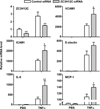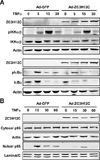Zc3h12c inhibits vascular inflammation by repressing NF-κB activation and pro-inflammatory gene expression in endothelial cells
- PMID: 23360436
- PMCID: PMC3922049
- DOI: 10.1042/BJ20130019
Zc3h12c inhibits vascular inflammation by repressing NF-κB activation and pro-inflammatory gene expression in endothelial cells
Abstract
Endothelial activation characterized by the expression of multiple chemokines and adhesive molecules is a critical initial step of vascular inflammation, which results in recruitment of leucocytes into the sub-endothelial layer of the vascular wall and triggers vascular inflammatory diseases such as atherosclerosis. Although inhibiting endothelial inflammation has already been well recognized as a therapeutic strategy in vascular inflammatory diseases, the therapeutic targets are still elusive. In the present study we found that Zc3h12c (zinc finger CCCH-type-containing 12C), a recently discovered CCCH zinc finger-containing protein, significantly inhibited the endothelial cell inflammatory response in vitro. Overexpression of Zc3h12c significantly attenuated TNFα (tumour necrosis factor α)-induced expression of chemokines and adhesive molecules, and thus reduced monocyte adherence to HUVECs (human umbilical vein endothelial cells). Conversely, siRNA (small interfering RNA)-mediated knockdown of Zc3h12c increased the TNFα-induced expression of chemokines and adhesive molecules in HUVECs. Furthermore, forced expression of Zc3h12c decreased TNFα-induced IKKα/β [IκB (inhibitor of nuclear factor κB) kinase α/β], IκBα phosphorylation and p65 nuclear translocation, suggesting that Zc3h12c exerted its anti-inflammatory function probably by suppressing the NF-κB (nuclear factor κB) pathway. Thus Zc3h12c is an endogenous inhibitor of TNFα-induced inflammatory signalling in HUVECs and might be a therapeutic target in vascular inflammatory diseases.
Figures






Similar articles
-
Bestrophin 3 ameliorates TNFα-induced inflammation by inhibiting NF-κB activation in endothelial cells.PLoS One. 2014 Oct 20;9(10):e111093. doi: 10.1371/journal.pone.0111093. eCollection 2014. PLoS One. 2014. PMID: 25329324 Free PMC article.
-
Regulation of Rela/p65 and endothelial cell inflammation by proline-rich tyrosine kinase 2.Am J Respir Cell Mol Biol. 2012 Nov;47(5):660-8. doi: 10.1165/rcmb.2012-0047OC. Epub 2012 Jul 27. Am J Respir Cell Mol Biol. 2012. PMID: 22842493 Free PMC article.
-
MicroRNA-17-3p suppresses NF-κB-mediated endothelial inflammation by targeting NIK and IKKβ binding protein.Acta Pharmacol Sin. 2021 Dec;42(12):2046-2057. doi: 10.1038/s41401-021-00611-w. Epub 2021 Feb 23. Acta Pharmacol Sin. 2021. PMID: 33623121 Free PMC article.
-
Luteolin protects against vascular inflammation in mice and TNF-alpha-induced monocyte adhesion to endothelial cells via suppressing IΚBα/NF-κB signaling pathway.J Nutr Biochem. 2015 Mar;26(3):293-302. doi: 10.1016/j.jnutbio.2014.11.008. Epub 2014 Dec 15. J Nutr Biochem. 2015. PMID: 25577468 Free PMC article.
-
Clematichinenoside inhibits VCAM-1 and ICAM-1 expression in TNF-α-treated endothelial cells via NADPH oxidase-dependent IκB kinase/NF-κB pathway.Free Radic Biol Med. 2015 Jan;78:190-201. doi: 10.1016/j.freeradbiomed.2014.11.004. Epub 2014 Nov 13. Free Radic Biol Med. 2015. PMID: 25463279
Cited by
-
Genes Downregulated in Endometriosis Are Located Near the Known Imprinting Genes.Reprod Sci. 2014 Aug;21(8):966-972. doi: 10.1177/1933719114526473. Epub 2014 Mar 10. Reprod Sci. 2014. PMID: 24615936 Free PMC article.
-
Genome-Wide Association Identifies SLC2A9 and NLN Gene Regions as Associated with Entropion in Domestic Sheep.PLoS One. 2015 Jun 22;10(6):e0128909. doi: 10.1371/journal.pone.0128909. eCollection 2015. PLoS One. 2015. PMID: 26098909 Free PMC article.
-
RNF144B negatively regulates antiviral immunity by targeting MDA5 for autophagic degradation.EMBO Rep. 2024 Oct;25(10):4594-4624. doi: 10.1038/s44319-024-00256-w. Epub 2024 Sep 16. EMBO Rep. 2024. PMID: 39285245 Free PMC article.
-
First genome-wide association study investigating blood pressure and renal traits in domestic cats.Sci Rep. 2022 Feb 3;12(1):1899. doi: 10.1038/s41598-022-05494-3. Sci Rep. 2022. PMID: 35115544 Free PMC article.
-
Monocyte Chemotactic Protein-Induced Protein 1 (MCPIP-1): A Key Player of Host Defense and Immune Regulation.Front Immunol. 2021 Oct 1;12:727861. doi: 10.3389/fimmu.2021.727861. eCollection 2021. Front Immunol. 2021. PMID: 34659213 Free PMC article. Review.
References
-
- Kinlay S, Libby P, Ganz P. Endothelial function and coronary artery disease. Curr. Opin. Lipidol. 2001;12:383–389. - PubMed
-
- Landmesser U, Hornig B, Drexler H. Endothelial function: a critical determinant in atherosclerosis? Circulation. 2004;109:II27–II33. - PubMed
-
- Bonetti PO, Lerman LO, Lerman A. Endothelial dysfunction: a marker of atherosclerotic risk. Arterioscler., Thromb., Vasc. Biol. 2003;23:168–175. - PubMed
-
- Li WG, Gavrila D, Liu X, Wang L, Gunnlaugsson S, Stoll LL, McCormick ML, Sigmund CD, Tang C, Weintraub NL. Ghrelin inhibits proinflammatory responses and nuclear factor-κB activation in human endothelial cells. Circulation. 2004;109:2221–2226. - PubMed
-
- Eto M, Kouroedov A, Cosentino F, Luscher TF. Glycogen synthase kinase-3 mediates endothelial cell activation by tumor necrosis factor-α. Circulation. 2005;112:1316–1322. - PubMed
Publication types
MeSH terms
Substances
Grants and funding
LinkOut - more resources
Full Text Sources
Other Literature Sources
Medical
Molecular Biology Databases
Miscellaneous

